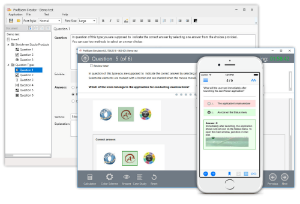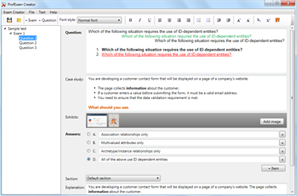File Info
| Exam | VMware NSX-T Data Center 3-1 Security |
| Number | 5V0-41.21 |
| File Name | VMware.5V0-41.21.VCEplus.2025-04-01.54q.tqb |
| Size | 1 MB |
| Posted | Apr 01, 2025 |
| Download | VMware.5V0-41.21.VCEplus.2025-04-01.54q.tqb |
How to open VCEX & EXAM Files?
Files with VCEX & EXAM extensions can be opened by ProfExam Simulator.
Coupon: MASTEREXAM
With discount: 20%
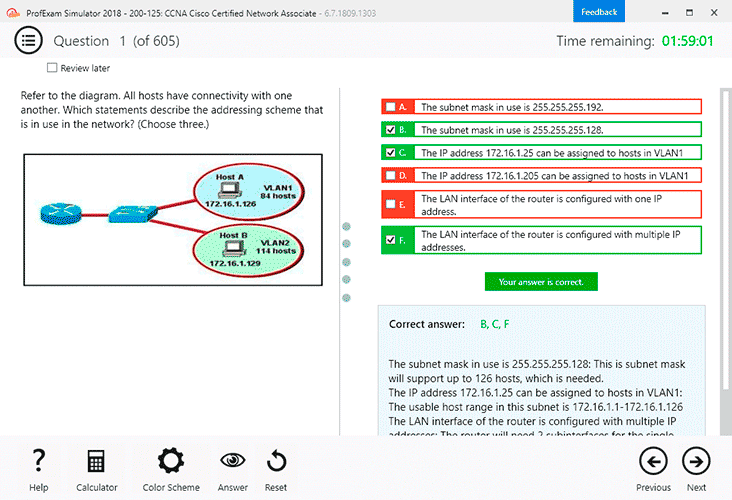

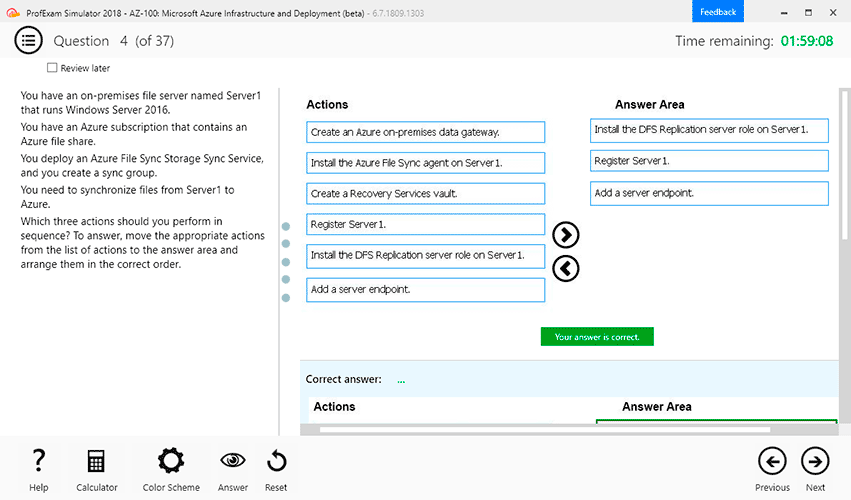
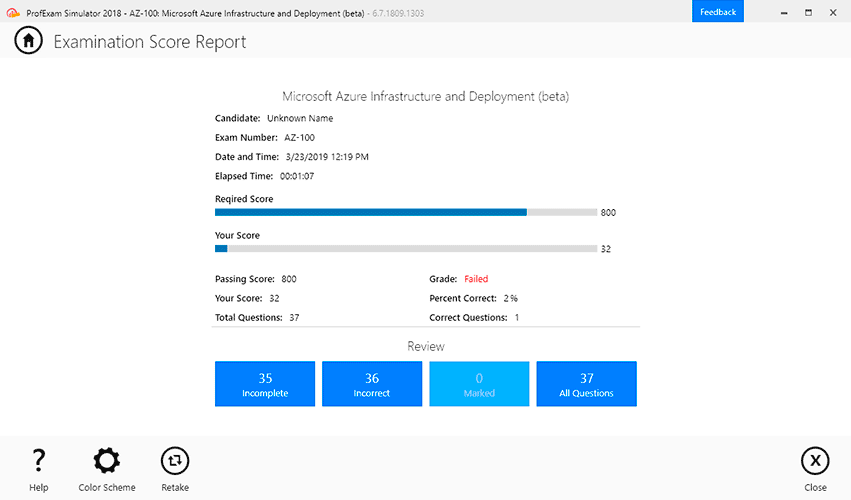
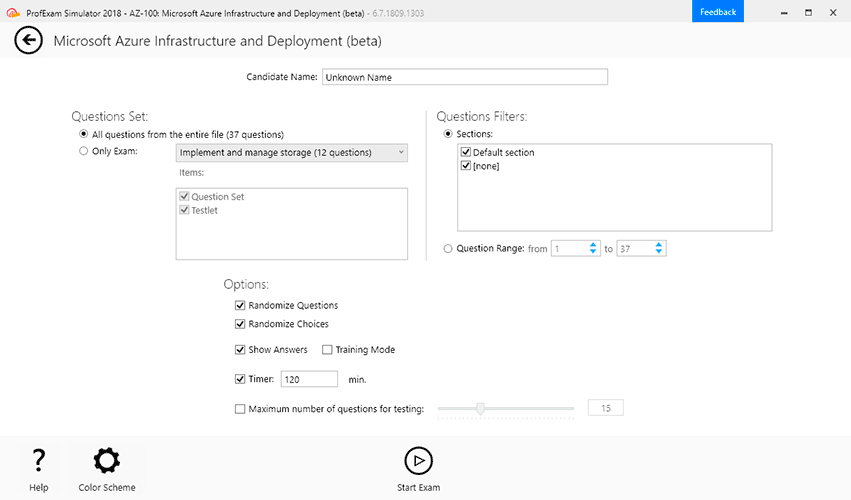

Demo Questions
Question 1
Which two criteria would an administrator use to filter firewall connection logs on NSX?
- FIREWALL MONITORING
- FIREWALL-PKTLOG
- FIREWALL RULE TAG
- FIREWALL CONNECTION
- FIREWALL SYSTEM
Correct answer: CD
Explanation:
An administrator can use the FIREWALL RULE TAG and FIREWALL CONNECTION criteria to filter the logs on NSX. The FIREWALL RULE TAG criteria allows the administrator to filter the logs based on the tag assigned to each rule, while the FIREWALL CONNECTION criteria allows the administrator to filter the logs based on the connection status (e.g. accepted or denied).For more information on how to filter firewall connection logs on NSX, please refer to the NSX-T Data Center documentation: https://docs.vmware.com/en/VMware-NSX-T-Data-Center/3.0/nsx-t-3.0- firewall/GUID-B6B835F2-B6F2-4468-8F8E-6F7B9B9D6E91.html An administrator can use the FIREWALL RULE TAG and FIREWALL CONNECTION criteria to filter the logs on NSX. The FIREWALL RULE TAG criteria allows the administrator to filter the logs based on the tag assigned to each rule, while the FIREWALL CONNECTION criteria allows the administrator to filter the logs based on the connection status (e.g. accepted or denied).
For more information on how to filter firewall connection logs on NSX, please refer to the NSX-T Data Center documentation: https://docs.vmware.com/en/VMware-NSX-T-Data-Center/3.0/nsx-t-3.0- firewall/GUID-B6B835F2-B6F2-4468-8F8E-6F7B9B9D6E91.html
Question 2
A security administrator is verifying why users are blocked from sports sites but are able to access gambling websites from the corporate network. What needs to be updated In nsx-T to block the gambling websites?
- vSphere Firewall Policy
- Endpoint Protection Rules
- Network Introspection Policy
- URL Analysis Attributes
Correct answer: D
Explanation:
In order to block the gambling websites, the security administrator needs to update the URL Analysis Attributes in NSX-T. URL Analysis Attributes are used to control access to web content, and can be configured to deny access to certain web destinations based on domain names or categories.For more information on URL Analysis Attributes and how to configure them, please refer to the NSXT Data Center documentation [1]: <>-profile/GUID-F8BA3F3F-4A27-4B4F-8D2A-A013F68E1619.htmlhttps://docs.vmware.com/en/VMware-vSphere/7.0/rn/vsphere-vcenter-server-703-releasenotes.html1. VMware vCenter Server 7.0 Update 3 Release Noteshttps://docs.vmware.com/en/VMware-vSphere/7.0/rn/vsphere-vcenter-server-703-releasenotes.html In order to block the gambling websites, the security administrator needs to update the URL Analysis Attributes in NSX-T. URL Analysis Attributes are used to control access to web content, and can be configured to deny access to certain web destinations based on domain names or categories.
For more information on URL Analysis Attributes and how to configure them, please refer to the NSXT Data Center documentation [1]: <>-profile/GUID-F8BA3F3F-4A27-4B4F-8D2A-A013F68E1619.html
https://docs.vmware.com/en/VMware-vSphere/7.0/rn/vsphere-vcenter-server-703-releasenotes.html
1. VMware vCenter Server 7.0 Update 3 Release Notes
https://docs.vmware.com/en/VMware-vSphere/7.0/rn/vsphere-vcenter-server-703-releasenotes.html
Question 3

Refer to the exhibit.

An administrator is reviewing NSX Intelligence information as shown in the exhibit.
What does the red dashed line for the UDP:137 flow represent?
- Discovered communication
- Allowed communication
- Blocked communication
- Unprotected communication
Correct answer: C
Explanation:
The red dashed line for the UDP:137 flow in the NSX Intelligence information represents blocked communication. This indicates that the NSX Distributed Firewall has blocked the communication between the source and destination IP addresses on port 137.For more information on NSX Intelligence and how to use it, please refer to the NSX-T Data Center documentation: https://docs.vmware.com/en/VMware-NSX-T-Data-Center/3.0/nsx-t-3.0- intelligence/GUID-C2B2AF2E-A76A-46B8-A67A-42D7A9E924A9.html The red dashed line for the UDP:137 flow in the NSX Intelligence information represents blocked communication. This indicates that the NSX Distributed Firewall has blocked the communication between the source and destination IP addresses on port 137.
For more information on NSX Intelligence and how to use it, please refer to the NSX-T Data Center documentation: https://docs.vmware.com/en/VMware-NSX-T-Data-Center/3.0/nsx-t-3.0- intelligence/GUID-C2B2AF2E-A76A-46B8-A67A-42D7A9E924A9.html
Question 4
Which two are the insertion points for North-South service insertion? (Choose two.)
- Partner Service VM
- Uplink of tier-1 gateway
- Transport Node NIC
- Guest VM vNIC
- Uplink of tier-0 gateway
Correct answer: DE
Explanation:
The tier-0 gateway is the entry point of the NSX-T Data Center network, and it is where the North- South service insertion takes place. The uplink of the tier-0 gateway is the point of connection between the NSX-T Data Center network and the external network.The guest VM vNIC is the interface card inside the guest virtual machine, which is used to connect the guest VM to the NSX-T Data Center network. North-South services can be inserted at this point as well.Reference: https://docs.vmware.com/en/VMware-NSX-T-Data-Center/3.1/nsxt_31_admin_guide/GUID-A3A6C7E1-8F5E-4A17-9B79-A3D836E3A6D3.html https://docs.vmware.com/en/VMware-NSX-T-Data-Center/3.1/nsxt The tier-0 gateway is the entry point of the NSX-T Data Center network, and it is where the North- South service insertion takes place. The uplink of the tier-0 gateway is the point of connection between the NSX-T Data Center network and the external network.
The guest VM vNIC is the interface card inside the guest virtual machine, which is used to connect the guest VM to the NSX-T Data Center network. North-South services can be inserted at this point as well.
Reference: https://docs.vmware.com/en/VMware-NSX-T-Data-Center/3.1/nsxt_31_admin_guide/GUID-A3A6C7E1-8F5E-4A17-9B79-A3D836E3A6D3.html https://docs.vmware.com/en/VMware-NSX-T-Data-Center/3.1/nsxt
Question 5
Which are two use-cases for the NSX Distributed Firewall' (Choose two.)
- Zero-Trust with segmentation
- Security Analytics
- Lateral Movement of Attacks prevention
- Software defined networking
- Network Visualization
Correct answer: AC
Explanation:
Zero-Trust with segmentation is a security strategy that uses micro-segmentation to protect a network from malicious actors. By breaking down the network into smaller segments, the NSX Distributed Firewall can create a zero-trust architecture which limits access to only users and devices that have been authorized. This reduces the risk of a malicious actor gaining access to sensitive data and systems.Lateral Movement of Attacks prevention is another use-case for the NSX Distributed Firewall. Lateral movement of attacks are when an attacker is already inside the network and attempts to move laterally between systems.The NSX Distributed Firewall can help protect the network from these attacks by controlling the flow of traffic between systems and preventing unauthorized access.Reference: https://www.vmware.com/products/nsx/distributedfirewall.html https://searchsecurity.techtarget.com/definition/zero-trust-network Zero-Trust with segmentation is a security strategy that uses micro-segmentation to protect a network from malicious actors. By breaking down the network into smaller segments, the NSX Distributed Firewall can create a zero-trust architecture which limits access to only users and devices that have been authorized. This reduces the risk of a malicious actor gaining access to sensitive data and systems.
Lateral Movement of Attacks prevention is another use-case for the NSX Distributed Firewall. Lateral movement of attacks are when an attacker is already inside the network and attempts to move laterally between systems.
The NSX Distributed Firewall can help protect the network from these attacks by controlling the flow of traffic between systems and preventing unauthorized access.
Reference: https://www.vmware.com/products/nsx/distributedfirewall.html https://searchsecurity.techtarget.com/definition/zero-trust-network
Question 6
An administrator wants to configure NSX-T Security Groups inside a distributed firewall rule. Which menu item would the administrator select to configure the Security Groups?
- System
- Inventory
- Security
- Networking
Correct answer: C
Explanation:
To configure NSX-T Security Groups inside a distributed firewall rule, the administrator would select the "Security" menu item in the NSX-T Manager user interface.Within the Security menu, the administrator would navigate to the "Groups" option, where they can create, edit, and manage security groups. These groups can then be used in the "Applied To" column when creating or editing firewall rules.In the Security menu, administrator can also configure other security features such as firewall, microsegmentation, intrusion detection and prevention, and endpoint protection.Reference:VMware NSX-T Data Center documentation https://docs.vmware.com/en/VMware-NSX-T-Data-Center/index.htmlVMware NSX-T Data Center Security Groups documentationhttps://docs.vmware.com/en/VMware-NSX-T-Data-Center/3.1/com.vmware.nsxt.groups.doc/GUID-8C8DDC52-0B91-4E9F-8D8EE1649D3C3BBD.html To configure NSX-T Security Groups inside a distributed firewall rule, the administrator would select the "Security" menu item in the NSX-T Manager user interface.
Within the Security menu, the administrator would navigate to the "Groups" option, where they can create, edit, and manage security groups. These groups can then be used in the "Applied To" column when creating or editing firewall rules.
In the Security menu, administrator can also configure other security features such as firewall, microsegmentation, intrusion detection and prevention, and endpoint protection.
Reference:
VMware NSX-T Data Center documentation https://docs.vmware.com/en/VMware-NSX-T-Data-Center/index.html
VMware NSX-T Data Center Security Groups documentation
https://docs.vmware.com/en/VMware-NSX-T-Data-Center/3.1/com.vmware.nsxt.groups.doc/GUID-8C8DDC52-0B91-4E9F-8D8EE1649D3C3BBD.html
Question 7
An NSX administrator has turned on logging for the distributed firewall rule. On an ESXi host, where will the logs be stored?
- /var/log/esxupdate.log
- /var/log/dfwpktlogs.log
- /var/log/hostd.log
- /var/log/vmkerntl.log
Correct answer: B
Explanation:
The NSX administrator has enabled logging for the distributed firewall rule, and the logs are stored in the /var/log/dfwpktlogs.log file on the ESXi host. This log file stores the packet logs for the distributed firewall rules, and the logs can be used for auditing and troubleshooting the distributed firewall.Reference: https://docs.vmware.com/en/VMware-NSX-T-Data-Center/2.5/nsxt_25_admin_guide/GUID-E0CC7D8A-F9E6-4A6F-A6F8-6A3D7B3DC3EF.html#GUIDE0CC7D8A- F9E6-4A6F-A6F8-6A3D7B3DC3EF The NSX administrator has enabled logging for the distributed firewall rule, and the logs are stored in the /var/log/dfwpktlogs.log file on the ESXi host. This log file stores the packet logs for the distributed firewall rules, and the logs can be used for auditing and troubleshooting the distributed firewall.
Reference: https://docs.vmware.com/en/VMware-NSX-T-Data-Center/2.5/nsxt_25_admin_guide/GUID-E0CC7D8A-F9E6-4A6F-A6F8-6A3D7B3DC3EF.html#GUIDE0CC7D8A- F9E6-4A6F-A6F8-6A3D7B3DC3EF
Question 8
A Security Administrator needs to update their NSX Distributed IDS/IPS policy to detect new attacks with critical CVSS scoring that leads to credential theft from targeted systems.
Which actions should you take?
- Update Distributed IDS/IPS signature database Edit your profile from Security > Distributed IDS > ProfilesSelect Critical severity, filter on attack type and select Successful Credential Theft DetectedCheck the profile is applied in Distributed IDS rules
- Edit your Distributed IDS rule from Security > Distributed IDS/IPS > Rules Filter on attack type and select Successful Credential Theft DetectedUpdate Mode to detect and preventClick on gear icon and change direction to OUT
- Create a new profile from Security > Distributed IDS > Profiles Select Critical severity, filter on attack type and select Successful Credential Theft DetectedCheck the profile is applied In Distributed IDS rulesMonitor Distributed IDS alerts to validate changes are applied
- Edit your Distributed IDS rule from Security > Distributed IDS/IPS > Rules Filter on attack type and select Successful Credential Theft DetectedUpdate Mode to detect and preventClick on gear icon and change direction to IN-OUT
Correct answer: A
Explanation:
https://docs.vmware.com/en/VMware-NSX-T-Data-Center/3.1/nsxt_31_ids_ips/GUID-B2D6A7F6- https://docs.vmware.com/en/VMware-NSX-T-Data-Center/3.1/nsxt_31_ids_ips/GUID-B2D6A7F6-
Question 9
Which is an insertion point for East-West service insertion?
- tier-1 gateway
- Partner SVM
- Guest VM vNlC
- transport node
Correct answer: C
Explanation:
East-West service insertion refers to the ability to insert security services, such as firewall and intrusion detection and prevention, between virtual machines (VMs) that are communicating within the same logical network.One of the insertion points for East-West service insertion is the virtual network interface card (vNIC) of the guest VM. The vNIC is the virtual representation of a physical NIC on a VM, and it connects the VM to the virtual network. By inserting security services at the vNIC level, traffic between VMs can be inspected and secured before it reaches the virtual switch.VMware NSX-T Data Center documentation https://docs.vmware.com/en/VMware-NSX-T-Data-Center/index.htmlVMware NSX-T Data Center Security documentationhttps://docs.vmware.com/en/VMware-NSX-TData-Center/3.1/com.vmware.nsxt.security.doc/GUID-8F7C8B70-F1A6-4F31-8D6CA0A9B9C9A9D3.html East-West service insertion refers to the ability to insert security services, such as firewall and intrusion detection and prevention, between virtual machines (VMs) that are communicating within the same logical network.
One of the insertion points for East-West service insertion is the virtual network interface card (vNIC) of the guest VM. The vNIC is the virtual representation of a physical NIC on a VM, and it connects the VM to the virtual network. By inserting security services at the vNIC level, traffic between VMs can be inspected and secured before it reaches the virtual switch.
VMware NSX-T Data Center documentation https://docs.vmware.com/en/VMware-NSX-T-Data-Center/index.html
VMware NSX-T Data Center Security documentation
https://docs.vmware.com/en/VMware-NSX-TData-Center/3.1/com.vmware.nsxt.security.doc/GUID-8F7C8B70-F1A6-4F31-8D6CA0A9B9C9A9D3.html
Question 10

An NSX administrator has been tasked with configuring a remote logging server (192.168.110.60) to send FW connections and packets logs to a remote logging server. The administrator is using this command syntax found in the NSX-T 3.1 documentation:

Which of the following commands does the administrator use to complete the configuration task?
- set logging-server 192.168.110.60 proto udp level info facility syslog message Id FIREWALLCONNECTION
- set logging-server 192.168.110.60 proto udp level info facility syslog message!- monitor. Firewall
- set logging-server 192.168.110.60 proto udp level info facility syslog message Id FIREWALLPKTLOG
- set logging-server 192.168.110.60 proto udp level info facility syslog message Id system, fabric
Correct answer: C
Explanation:
The administrator is using the command syntax found in the NSX-T 3.1 documentation to configure a remote logging server to send firewall connections and packets logs. In order to complete the configuration task, the administrator needs to use the correct options for the command.The options used in the command are: logging-server: This option specifies the IP address or hostname of the remote logging server. In this case, the IP address of the remote logging server is 192.168.110.60. proto: This option specifies the protocol to be used to send the logs to the remote server. In this case, the protocol used is UDP. level: This option specifies the level of logging to be sent to the remote server. In this case, the level of logging is "info" facility: This option specifies the facility to be used for syslog messages. In this case, the facility used is "syslog" message Id: This option specifies the message Id that will be used for the logs. In this case, the message Id used is "FIREWALL-PKTLOG"Reference:VMware NSX-T Data Center documentation https://docs.vmware.com/en/VMware-NSX-T-Data-Center/index.htmlVMware NSX-T Data Center Logging documentationhttps://docs.vmware.com/en/VMware-NSX-TData-Center/3.1/com.vmware.nsxt.logging.doc/GUID-2B9E9F8D-6CA9-4A1E-B7B1-8B8C7F0C2B2E.html The administrator is using the command syntax found in the NSX-T 3.1 documentation to configure a remote logging server to send firewall connections and packets logs. In order to complete the configuration task, the administrator needs to use the correct options for the command.
The options used in the command are: logging-server: This option specifies the IP address or hostname of the remote logging server. In this case, the IP address of the remote logging server is 192.168.110.60. proto: This option specifies the protocol to be used to send the logs to the remote server. In this case, the protocol used is UDP. level: This option specifies the level of logging to be sent to the remote server. In this case, the level of logging is "info" facility: This option specifies the facility to be used for syslog messages. In this case, the facility used is "syslog" message Id: This option specifies the message Id that will be used for the logs. In this case, the message Id used is "FIREWALL-PKTLOG"
Reference:
VMware NSX-T Data Center documentation https://docs.vmware.com/en/VMware-NSX-T-Data-Center/index.html
VMware NSX-T Data Center Logging documentation
https://docs.vmware.com/en/VMware-NSX-TData-Center/3.1/com.vmware.nsxt.logging.doc/GUID-2B9E9F8D-6CA9-4A1E-B7B1-8B8C7F0C2B2E.html
